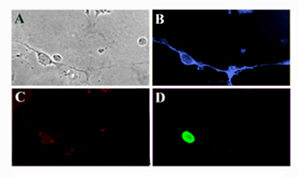I am currently working in the lab of Dr. Regina Armstrong, at the Uniformed Services University in Bethesda Maryland.
The main interest of the lab is the "Oligodendrocyte lineage cell repopulation of demyelinated lesions in a mouse model that accomplishes effective remyelination and functional recovery", and the role of growth factors in this process.
For the last two years I have been investigating the role of the growth factors platelet-derived growth factor (PDGF) and fibroblast growth factor 2 (FGF2) in the regulation of adult oligodendrocyte precursor proliferation.
This involves isolating mixed glial cell preps from the spinal cord of adult mice which are displaying symptoms of severe demyelination. After 2 days in vitro, PDGF and/or FGF2, or inhibitors which are specific for either or both growth factor, are added to the cultures for a further 3 days. At this point BrdU is added to the cultures to assess the extent of proliferation in the cultures, and the cells are fixed and stained for NG2, a marker of early stage progenitor cells, or O1, a marker of later stages of the lineage. Numbers of cells are then assessed by fluorescent microscopy, and expressed as the proportion of each lineage stage that have incorporated BrdU.
The major conclusion of this study is that a combination of the growth factors regulates the proliferation of oligodendrocyte progenitor cells in these cultures.
This work was initially presented at the American Society for Neurochemistry Spring meeting, in Chicago, 2000.
